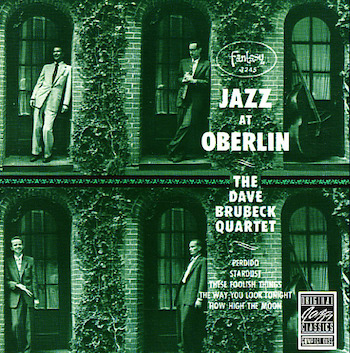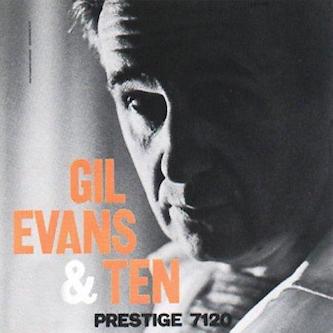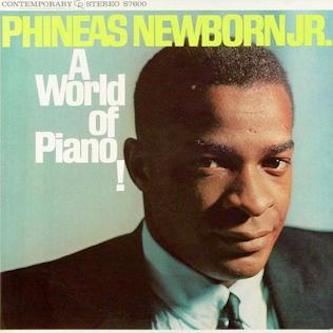Jazz Album Reviews: Craft LP Reissues — Prime Examples of the Golden Age of Jazz Recording
By Michael Ulman
These jazz albums are splendid representations of the first full decade of LPs and of stereo recording as well.
Dave Brubeck Quartet, Jazz at Oberlin (Fantasy/ Craft)
Bill Evans Trio, Sunday at the Village Vanguard (Riverside/Craft)
Gil Evans, Gil Evans & Ten (Prestige/Craft)
Art Farmer, Portrait of Art Farmer (Contemporary/Craft)
Phineas Newborn, A World of Piano! (Contemporary/Craft)

These Craft LP reissues celebrate and revivify sessions made between March of 1953 (the Brubeck quartet) and April of 1958 (the Art Farmer). It was a golden age of recording: a golden age of jazz really. Louis Armstrong and Duke Ellington were performing all over the world, Coltrane and Sonny Rollins emerged fully from their chrysalises, the Miles Davis quintet made its series of Prestige sessions (Cookin’ is my favorite) and Art Blakey and Horace Silver were playing distinctive hard bop while Ornette Coleman made his first free jazz recordings. Earlier in the decade one could hear, performing live, Charlie Parker, Lester Young, Billie Holiday, and Art Tatum. Lurking in the near future were the 1959 blockbuster recordings Kind of Blue and Time Out. The raucous, gospel-infused Mingus records (Mingus Ah Um and Blues and Roots) shouted joyously at us at the same time the relatively demure, yet tension-filled pieces of the Modern Jazz Quartet were appealing to the sophisticated. It was the first full decade of LPs and also of stereo recording.
The best young jazz men were busy. Consider a few of the recordings trumpeter Art Farmer was on around the time of Portrait of Art Farmer: Sonny Clark’s Cool Struttin, Horace Silver’s Further Explorations, Mulligan’s I Want to Live, Ben Webster’s Soul of Ben Webster, Mundell Lowe’s Porgy and Bess, and John Benson Brooks’s Alabama Concerto. Thanks to Dave Brubeck and others, the jazz audience was expanding into colleges. My ancient copy of Brubeck’s Jazz at Oberlin, which was recorded in mono, seemed to me to suffer from the slightly overly resonant venue, the Finney Chapel at Oberlin: the band feels a little muffled, and there is an occasional burble in the sound, as at the beginning of Paul Desmond’s marvelous solo on “My Favorite Things.” The crowd bursts into spontaneous applause toward the end of the solo. Brubeck’s ensuing solo is played quietly and with (for him) unusual restraint that allows us to hear his harmonic twists and turns. Soon he is more aggressive, thumping with both hands, stopping as if surprised at himself, and then resuming. The band is not yet the Time Out quartet: the bassist here is Ron Crotty and the drummer Lloyd Davis. The Craft LP is clearer than my earlier recording. Brubeck fans will want this one, and Craft has made the best of the recorded sound.
 Gil Evans’s Gil Evans and Ten was recorded on March 3, 1958, in both mono and stereo. Surprisingly (perhaps), it is presented here in mono. This is Evans’s first LP under his own name, though he was hardly a newcomer. He had led his own band in California. (Trumpeter Jimmy Maxwell was in the California band and told me that Evans was already interested in the colors such instruments as the French horn could bring to the band.) Starting in 1939, and continuing for a decade, he wrote advanced arrangements for Claude Thornhill’s big band, and of course he wrote “Boplicity” and arranged “Moon Dreams” for the Miles Davis nonet in 1949. Soon he’d be the composer/arranger of the celebrated Davis big band albums, including Miles Ahead. On Gil Evans Plus Ten, Evans’s band includes a French horn (Willie Ruff), bassoon (Dave Kurtzer), and such well-known jazz men as Steve Lacy, Lee Konitz, and the marvelous trombonist Jimmy Cleveland, The colorful weightiness of the orchestra offsets the spirited soloists, such as Steve Lacy on soprano and Lee Konitz on alto. The mono sound of the Craft LP is advantageous to my ears in one way: it solidifies the blended sounds of the orchestra. The solos are marvelous: Lacy and Jimmy Cleveland especially. The highlight of “Ella Speed,” the folk tune Evans learned from Leadbelly, is to me the dashing tutti chorus. Paul Chambers then bows a solo. On “Just One of Those Things,” Lacy solos for two choruses on soprano saxophone, then still an exotic instrument. The first chorus of “If You Could See Me Now” is given over to Cleveland’s trombone, whereas the opening of “Jambangle” uses boogie woogie figures before Evans solos. I find myself preferring this mono version to any other I have heard because of the solidity of the orchestral sounds. Listen to the opening of “Big Stuff” and you’ll see what I mean — it’s the perfect blend of dark and light.
Gil Evans’s Gil Evans and Ten was recorded on March 3, 1958, in both mono and stereo. Surprisingly (perhaps), it is presented here in mono. This is Evans’s first LP under his own name, though he was hardly a newcomer. He had led his own band in California. (Trumpeter Jimmy Maxwell was in the California band and told me that Evans was already interested in the colors such instruments as the French horn could bring to the band.) Starting in 1939, and continuing for a decade, he wrote advanced arrangements for Claude Thornhill’s big band, and of course he wrote “Boplicity” and arranged “Moon Dreams” for the Miles Davis nonet in 1949. Soon he’d be the composer/arranger of the celebrated Davis big band albums, including Miles Ahead. On Gil Evans Plus Ten, Evans’s band includes a French horn (Willie Ruff), bassoon (Dave Kurtzer), and such well-known jazz men as Steve Lacy, Lee Konitz, and the marvelous trombonist Jimmy Cleveland, The colorful weightiness of the orchestra offsets the spirited soloists, such as Steve Lacy on soprano and Lee Konitz on alto. The mono sound of the Craft LP is advantageous to my ears in one way: it solidifies the blended sounds of the orchestra. The solos are marvelous: Lacy and Jimmy Cleveland especially. The highlight of “Ella Speed,” the folk tune Evans learned from Leadbelly, is to me the dashing tutti chorus. Paul Chambers then bows a solo. On “Just One of Those Things,” Lacy solos for two choruses on soprano saxophone, then still an exotic instrument. The first chorus of “If You Could See Me Now” is given over to Cleveland’s trombone, whereas the opening of “Jambangle” uses boogie woogie figures before Evans solos. I find myself preferring this mono version to any other I have heard because of the solidity of the orchestral sounds. Listen to the opening of “Big Stuff” and you’ll see what I mean — it’s the perfect blend of dark and light.
The lyrical, warm-toned trumpet player Art Farmer recorded his Portrait of Art Farmer on a single day: April 19, 1958. He had admirable backup: Hank Jones on piano, Addison Farmer on bass, and Roy Haynes on drums. Farmer was flying high in those years, the beneficiary of a recent jazz hit, the uptempo “Farmer’s Market,” which featured Wardell Gray and Hampton Hawes. First recorded in January, 1952, “Farmer’s Market” was sung vocalese style by Annie Ross in the following October. Hers is a story about a girl from the sticks who goes to the market and falls for a guy in jeans selling beans. It doesn’t make much sense, but at the time it sounded very hip.

Portrait of Art Farmer begins with a beautiful, closely miked trumpet solo by the leader. The tune is Farmer’s blues, “Back in the Cage.” The LP ends with another Farmer blues, which he calls simply “Earth.” (“I’m not really a writer,” he says.) The recorded sound is excellent, with each instrument standing out clearly. The engineers were showing off the stereo effect. The rhythm section is on the right channel: Farmer is by his lonesome on the left. The band does a rarely played George Russell tune, “Nita,” with unusual twists and turns. To me, the highlight of an exquisitely played set is the ballad “The Very Thought of You.” Farmer plays the entire first chorus muted, as if he is telling us secrets. Others might prefer the album’s open-horned version of Benny Golson’s “Stablemates,” with its accomplished solo by the Nat King Cole-influenced Hank Jones, or the rendition of Lerner and Lane’s poignant “Too Late Now.” I am pulling for Craft to reissue Farmer’s Modern Art, also from 1958. It features Bill Evans as well as Benny Golson.
Bill Evans’s Sunday at the Village Vanguard, which was recorded on June 25, 1961, and its companion LP, Waltz for Debby, are two of this giant’s most celebrated recordings. Both feature the bass of Scott LaFaro and the drums of Paul Motian. It was almost the group’s swan song. LaFaro would be killed in a car crash on July 6. It’s a joy to listen to this Craft LP: the silence of the pressing, the focused sound of LaFaro’s bass. Here the stereo effect is dramatic, with Evans’s piano holding down the right channel exclusively. The trio was working on becoming more “democratic,” sharing the lead, allowing each member to comment, to make musical suggestions. The results are at their most dramatic on Miles Davis’s “Solar.” Evans begins playing Davis’s appealing melody and then, suddenly, LaFaro leaps in and from then on the two become engaged in a sprightly conversation in and around the melody. It’s magical.

Phineas Newborn’s A World of Piano! (Contemporary/Craft) is another gem from a more controversial, or at least less understood, pianist. Newborn was from Memphis and early on developed a prodigious technique that, paradoxically, seemed to disturb some critics. Leonard Feather said that such naysayers “harbor misgivings about technical perfection.” Art Tatum was another example of a perfection that some found annoying. They should realize that Tatum was adding a color to his improvisations with his rapid downward runs. He wasn’t showing off. Nor was Newborn when he recorded the uptempo version of Clifford Brown’s “Daahoud” on A World of Piano!, a recording that was made in two sessions in Los Angeles on October 16, 1961, and on November 21. Interestingly, the two sessions sound different. On side one, bassist Paul Chambers and drummer Philly Joe Jones accompany Newborn, who shows himself to be a bebop giant on Charlie Parker’s “Cheryl,” Dizzy Gillespie’s “Manteca,” and Brown’s “Daahoud.” The second side has bassist Sam Jones and drummer Louis Hayes. On side one of this LP bassist Chambers is set further back in the mix than is Sam Jones on side two. Newborn’s version of Billy Strayhorn’s “Lush Life” begins with the pianist soloing an improvised introduction. When he reaches the composed melody, Newborn remains virtuosic in his use of runs, startling accents, and sudden bars of sweet reticence. We also get to hear Philly Joe Jones solo on “Daahoud” and elsewhere. Newborn plays a rare Horace Silver tune, “Juicy Lucy,” and bassist Leroy Vinnegar’s “For Carl.” His repertoire is fresh. To me, Newborn’s piano playing remains as inviting as it is exciting: his trios are the bomb.
Michael Ullman studied classical clarinet and was educated at Harvard, from which he received a PhD in English. The author or co-author of two books on jazz, he has written on jazz and classical music for the Atlantic Monthly, New Republic, High Fidelity, Stereophile, Boston Phoenix, Boston Globe, and other venues. His articles on Dickens, Joyce, Kipling, and others have appeared in academic journals. For over 20 years, he has written a bi-monthly jazz column for Fanfare Magazine, for which he also reviews classical music. At Tufts University, he teaches mostly modernist writers in the English Department and jazz and blues history in the Music Department. He plays piano badly.
